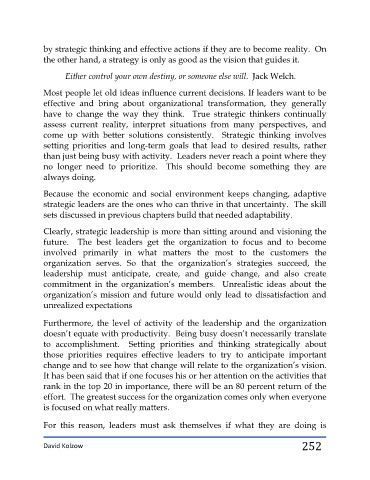Page 252 - 4- Leading_from_Within
P. 252
by strategic thinking and effective actions if they are to become reality. On
the other hand, a strategy is only as good as the vision that guides it.
Either control your own destiny, or someone else will. Jack Welch.
Most people let old ideas influence current decisions. If leaders want to be
effective and bring about organizational transformation, they generally
have to change the way they think. True strategic thinkers continually
assess current reality, interpret situations from many perspectives, and
come up with better solutions consistently. Strategic thinking involves
setting priorities and long-term goals that lead to desired results, rather
than just being busy with activity. Leaders never reach a point where they
no longer need to prioritize. This should become something they are
always doing.
Because the economic and social environment keeps changing, adaptive
strategic leaders are the ones who can thrive in that uncertainty. The skill
sets discussed in previous chapters build that needed adaptability.
Clearly, strategic leadership is more than sitting around and visioning the
future. The best leaders get the organization to focus and to become
involved primarily in what matters the most to the customers the
organization serves. So that the organization’s strategies succeed, the
leadership must anticipate, create, and guide change, and also create
commitment in the organization’s members. Unrealistic ideas about the
organization’s mission and future would only lead to dissatisfaction and
unrealized expectations
Furthermore, the level of activity of the leadership and the organization
doesn’t equate with productivity. Being busy doesn’t necessarily translate
to accomplishment. Setting priorities and thinking strategically about
those priorities requires effective leaders to try to anticipate important
change and to see how that change will relate to the organization’s vision.
It has been said that if one focuses his or her attention on the activities that
rank in the top 20 in importance, there will be an 80 percent return of the
effort. The greatest success for the organization comes only when everyone
is focused on what really matters.
For this reason, leaders must ask themselves if what they are doing is
David Kolzow 252

